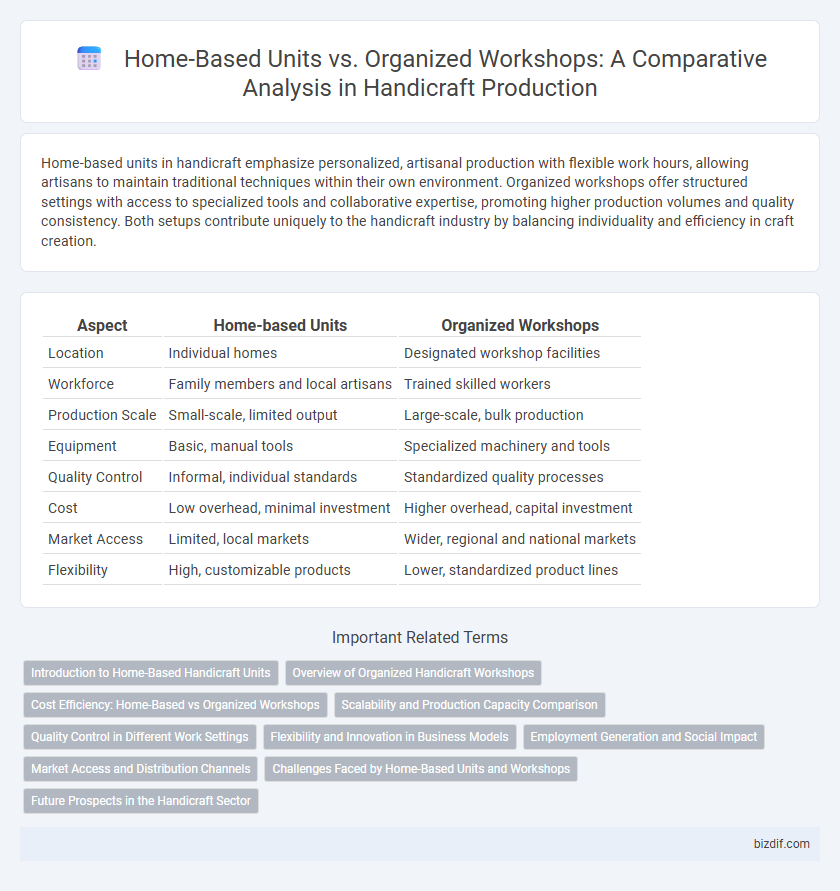Home-based units in handicraft emphasize personalized, artisanal production with flexible work hours, allowing artisans to maintain traditional techniques within their own environment. Organized workshops offer structured settings with access to specialized tools and collaborative expertise, promoting higher production volumes and quality consistency. Both setups contribute uniquely to the handicraft industry by balancing individuality and efficiency in craft creation.
Table of Comparison
| Aspect | Home-based Units | Organized Workshops |
|---|---|---|
| Location | Individual homes | Designated workshop facilities |
| Workforce | Family members and local artisans | Trained skilled workers |
| Production Scale | Small-scale, limited output | Large-scale, bulk production |
| Equipment | Basic, manual tools | Specialized machinery and tools |
| Quality Control | Informal, individual standards | Standardized quality processes |
| Cost | Low overhead, minimal investment | Higher overhead, capital investment |
| Market Access | Limited, local markets | Wider, regional and national markets |
| Flexibility | High, customizable products | Lower, standardized product lines |
Introduction to Home-Based Handicraft Units
Home-based handicraft units operate within individual homes, enabling artisans to create products using traditional skills without the need for large-scale infrastructure. These units promote personalized craftsmanship, often involving family members, and rely on locally sourced materials to produce unique, culturally significant items. Compared to organized workshops, home-based units offer greater flexibility and preserve artisanal heritage by maintaining direct artisan engagement throughout the production process.
Overview of Organized Handicraft Workshops
Organized handicraft workshops combine skilled artisans under regulated environments to enhance productivity and maintain quality standards in traditional craft production. These workshops benefit from better resource allocation, access to advanced tools, and coordinated marketing efforts compared to home-based units. Structured management in organized workshops supports consistent craftsmanship and scalability, crucial for meeting commercial demand in handicraft markets.
Cost Efficiency: Home-Based vs Organized Workshops
Home-based handicraft units demonstrate significant cost efficiency due to minimal overhead expenses, such as rent and utilities, compared to organized workshops that incur higher fixed costs for infrastructure and machinery. Labor costs in home-based setups are often lower since artisans work within family units, reducing wage expenditure and enhancing flexible production schedules. Conversely, organized workshops benefit from economies of scale in procurement and standardized quality control, though these advantages are counterbalanced by the intensive capital investment and administrative expenses.
Scalability and Production Capacity Comparison
Home-based units in handicraft rely on skilled artisans working individually or in small groups, limiting scalability due to constrained resources and workspace. Organized workshops harness collective labor, advanced tools, and streamlined processes, significantly boosting production capacity and enabling large-scale order fulfillment. This centralized structure enhances quality control and accelerates output, making workshops more suitable for expanding market demands.
Quality Control in Different Work Settings
Home-based handicraft units often face challenges in maintaining consistent quality control due to limited resources, varying skill levels, and lack of standardized processes. Organized workshops implement structured quality control measures, including skilled supervision, standardized materials, and systematic inspection protocols that ensure uniformity and higher product standards. The controlled environment of workshops reduces defects and enhances craftsmanship reliability compared to the decentralized nature of home-based production.
Flexibility and Innovation in Business Models
Home-based handicraft units offer unparalleled flexibility, allowing artisans to innovate with personalized techniques and adapt quickly to market trends. Organized workshops benefit from structured workflows and collaborative environments, which streamline production but may limit individual creativity. Balancing the adaptability of home-based units with the efficiency of organized workshops enhances business models in the handicraft industry.
Employment Generation and Social Impact
Home-based units in handicraft sectors generate significant employment by enabling artisans, particularly women and marginalized groups, to work flexibly from their homes, thus promoting inclusive economic participation. Organized workshops offer structured environments with better access to tools, training, and quality control, leading to higher productivity and skill development among workers. Both models contribute to social impact by preserving traditional crafts and enhancing community livelihoods, but home-based units excel in empowering rural households while organized workshops foster collaboration and scalability.
Market Access and Distribution Channels
Home-based handicraft units often face limited market access and rely heavily on local or informal distribution channels, restricting their sales potential. Organized workshops benefit from established networks and partnerships that provide broader market reach, including national and international platforms. Efficient distribution channels in organized setups streamline product delivery and enhance market visibility, driving higher sales and growth opportunities.
Challenges Faced by Home-Based Units and Workshops
Home-based handicraft units face challenges such as limited access to modern tools, difficulty in scaling production, and inadequate market exposure, which restrict their growth potential. Organized workshops encounter issues like higher operational costs, stringent regulatory compliance, and the need for skilled labor to maintain quality standards. Both settings struggle with consistent raw material supply and competition from mass-produced goods, impacting their sustainability in the handicraft industry.
Future Prospects in the Handicraft Sector
Home-based handicraft units offer greater flexibility and personalized craftsmanship, fostering unique product development and sustaining traditional skills. Organized workshops benefit from economies of scale, advanced technology integration, and enhanced market access, enabling mass production and competitive pricing. Future prospects in the handicraft sector emphasize hybrid models combining artisanal creativity with modern manufacturing and digital marketing to expand global reach and ensure sustainable growth.
Home-based Units vs Organized Workshops Infographic

 bizdif.com
bizdif.com